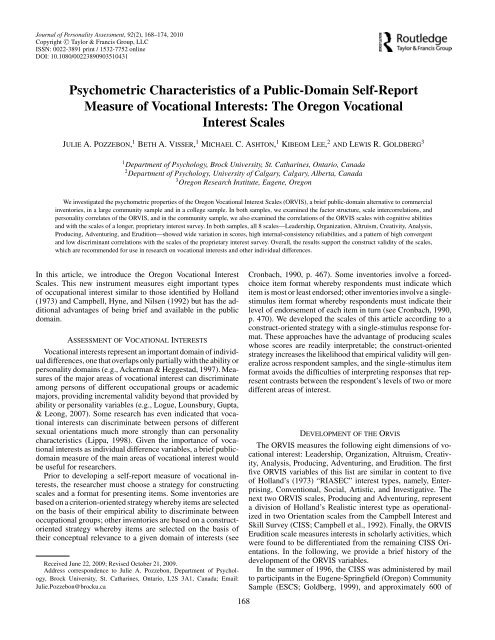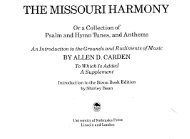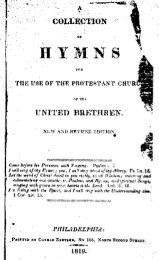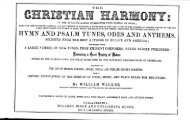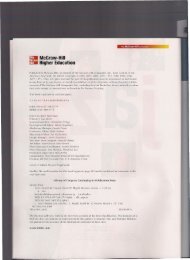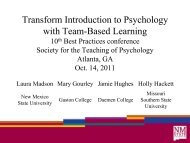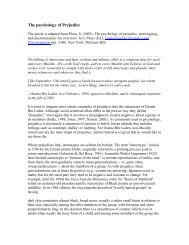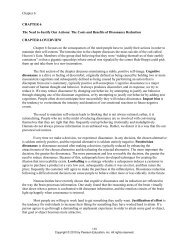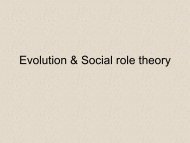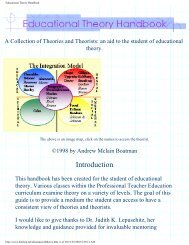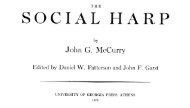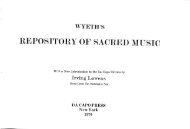Pozzebon et al.,2010
Pozzebon et al.,2010
Pozzebon et al.,2010
Create successful ePaper yourself
Turn your PDF publications into a flip-book with our unique Google optimized e-Paper software.
Journ<strong>al</strong> of Person<strong>al</strong>ity Assessment, 92(2), 168–174, <strong>2010</strong><br />
Copyright C○ Taylor & Francis Group, LLC<br />
ISSN: 0022-3891 print / 1532-7752 online<br />
DOI: 10.1080/00223890903510431<br />
Psychom<strong>et</strong>ric Characteristics of a Public-Domain Self-Report<br />
Measure of Vocation<strong>al</strong> Interests: The Oregon Vocation<strong>al</strong><br />
Interest Sc<strong>al</strong>es<br />
JULIE A. POZZEBON, 1 BETH A. VISSER, 1 MICHAEL C. ASHTON, 1 KIBEOM LEE, 2 AND LEWIS R. GOLDBERG 3<br />
1 Department of Psychology, Brock University, St. Catharines, Ontario, Canada<br />
2 Department of Psychology, University of C<strong>al</strong>gary, C<strong>al</strong>gary, Alberta, Canada<br />
3 Oregon Research Institute, Eugene, Oregon<br />
We investigated the psychom<strong>et</strong>ric properties of the Oregon Vocation<strong>al</strong> Interest Sc<strong>al</strong>es (ORVIS), a brief public-domain <strong>al</strong>ternative to commerci<strong>al</strong><br />
inventories, in a large community sample and in a college sample. In both samples, we examined the factor structure, sc<strong>al</strong>e intercorrelations, and<br />
person<strong>al</strong>ity correlates of the ORVIS, and in the community sample, we <strong>al</strong>so examined the correlations of the ORVIS sc<strong>al</strong>es with cognitive abilities<br />
and with the sc<strong>al</strong>es of a longer, propri<strong>et</strong>ary interest survey. In both samples, <strong>al</strong>l 8 sc<strong>al</strong>es—Leadership, Organization, Altruism, Creativity, An<strong>al</strong>ysis,<br />
Producing, Adventuring, and Erudition—showed wide variation in scores, high intern<strong>al</strong>-consistency reliabilities, and a pattern of high convergent<br />
and low discriminant correlations with the sc<strong>al</strong>es of the propri<strong>et</strong>ary interest survey. Over<strong>al</strong>l, the results support the construct v<strong>al</strong>idity of the sc<strong>al</strong>es,<br />
which are recommended for use in research on vocation<strong>al</strong> interests and other individu<strong>al</strong> differences.<br />
In this article, we introduce the Oregon Vocation<strong>al</strong> Interest<br />
Sc<strong>al</strong>es. This new instrument measures eight important types<br />
of occupation<strong>al</strong> interest similar to those identified by Holland<br />
(1973) and Campbell, Hyne, and Nilsen (1992) but has the addition<strong>al</strong><br />
advantages of being brief and available in the public<br />
domain.<br />
ASSESSMENT OF VOCATIONAL INTERESTS<br />
Vocation<strong>al</strong> interests represent an important domain of individu<strong>al</strong><br />
differences, one that overlaps only parti<strong>al</strong>ly with the ability or<br />
person<strong>al</strong>ity domains (e.g., Ackerman & Heggestad, 1997). Measures<br />
of the major areas of vocation<strong>al</strong> interest can discriminate<br />
among persons of different occupation<strong>al</strong> groups or academic<br />
majors, providing increment<strong>al</strong> v<strong>al</strong>idity beyond that provided by<br />
ability or person<strong>al</strong>ity variables (e.g., Logue, Lounsbury, Gupta,<br />
& Leong, 2007). Some research has even indicated that vocation<strong>al</strong><br />
interests can discriminate b<strong>et</strong>ween persons of different<br />
sexu<strong>al</strong> orientations much more strongly than can person<strong>al</strong>ity<br />
characteristics (Lippa, 1998). Given the importance of vocation<strong>al</strong><br />
interests as individu<strong>al</strong> difference variables, a brief publicdomain<br />
measure of the main areas of vocation<strong>al</strong> interest would<br />
be useful for researchers.<br />
Prior to developing a self-report measure of vocation<strong>al</strong> interests,<br />
the researcher must choose a strategy for constructing<br />
sc<strong>al</strong>es and a format for presenting items. Some inventories are<br />
based on a criterion-oriented strategy whereby items are selected<br />
on the basis of their empiric<strong>al</strong> ability to discriminate b<strong>et</strong>ween<br />
occupation<strong>al</strong> groups; other inventories are based on a constructoriented<br />
strategy whereby items are selected on the basis of<br />
their conceptu<strong>al</strong> relevance to a given domain of interests (see<br />
Received June 22, 2009; Revised October 21, 2009.<br />
Address correspondence to Julie A. <strong>Pozzebon</strong>, Department of Psychology,<br />
Brock University, St. Catharines, Ontario, L2S 3A1, Canada; Email:<br />
Julie.<strong>Pozzebon</strong>@brocku.ca<br />
168<br />
Cronbach, 1990, p. 467). Some inventories involve a forcedchoice<br />
item format whereby respondents must indicate which<br />
item is most or least endorsed; other inventories involve a singlestimulus<br />
item format whereby respondents must indicate their<br />
level of endorsement of each item in turn (see Cronbach, 1990,<br />
p. 470). We developed the sc<strong>al</strong>es of this article according to a<br />
construct-oriented strategy with a single-stimulus response format.<br />
These approaches have the advantage of producing sc<strong>al</strong>es<br />
whose scores are readily interpr<strong>et</strong>able; the construct-oriented<br />
strategy increases the likelihood that empiric<strong>al</strong> v<strong>al</strong>idity will gener<strong>al</strong>ize<br />
across respondent samples, and the single-stimulus item<br />
format avoids the difficulties of interpr<strong>et</strong>ing responses that represent<br />
contrasts b<strong>et</strong>ween the respondent’s levels of two or more<br />
different areas of interest.<br />
DEVELOPMENT OF THE ORVIS<br />
The ORVIS measures the following eight dimensions of vocation<strong>al</strong><br />
interest: Leadership, Organization, Altruism, Creativity,<br />
An<strong>al</strong>ysis, Producing, Adventuring, and Erudition. The first<br />
five ORVIS variables of this list are similar in content to five<br />
of Holland’s (1973) “RIASEC” interest types, namely, Enterprising,<br />
Convention<strong>al</strong>, Soci<strong>al</strong>, Artistic, and Investigative. The<br />
next two ORVIS sc<strong>al</strong>es, Producing and Adventuring, represent<br />
a division of Holland’s Re<strong>al</strong>istic interest type as operation<strong>al</strong>ized<br />
in two Orientation sc<strong>al</strong>es from the Campbell Interest and<br />
Skill Survey (CISS; Campbell <strong>et</strong> <strong>al</strong>., 1992). Fin<strong>al</strong>ly, the ORVIS<br />
Erudition sc<strong>al</strong>e measures interests in scholarly activities, which<br />
were found to be differentiated from the remaining CISS Orientations.<br />
In the following, we provide a brief history of the<br />
development of the ORVIS variables.<br />
In the summer of 1996, the CISS was administered by mail<br />
to participants in the Eugene-Springfield (Oregon) Community<br />
Sample (ESCS; Goldberg, 1999), and approximately 600 of
OREGON VOCATIONAL INTEREST SCALES 169<br />
them compl<strong>et</strong>ed the survey. 1 Over the years, Goldberg has carried<br />
out a number of an<strong>al</strong>yses of CISS sc<strong>al</strong>es, the most important<br />
of which for our purposes were an<strong>al</strong>yses of the seven CISS Orientation<br />
sc<strong>al</strong>es. To develop public-domain measures of each of<br />
the CISS Orientations, 2,035 items from the Internation<strong>al</strong> Person<strong>al</strong>ity<br />
Item Pool (IPIP; Goldberg, 1999) were correlated with<br />
the seven sc<strong>al</strong>e scores, and IPIP items were classified by the<br />
CISS sc<strong>al</strong>e with which they were most highly associated. IPIP<br />
items f<strong>al</strong>ling within each category were then selected ration<strong>al</strong>ly<br />
based on the extent of their correlations with the CISS sc<strong>al</strong>e, the<br />
apparent relevance of their content to the construct, and their<br />
lack of redundancy with other items <strong>al</strong>ready selected for that<br />
IPIP sc<strong>al</strong>e. Fin<strong>al</strong>ly, the reliability of preliminary versions of the<br />
new sc<strong>al</strong>es were an<strong>al</strong>yzed, and any items that served to attenuate<br />
sc<strong>al</strong>e reliability were omitted and in some cases replaced with<br />
other IPIP items that functioned more adequately.<br />
All IPIP items are short phrases, beginning with a verb (e.g.,<br />
“Take risks,” “T<strong>al</strong>k softly”). Those IPIP items that turned out<br />
to be most highly associated with the CISS sc<strong>al</strong>es typic<strong>al</strong>ly<br />
included verb<strong>al</strong> phrases involving interest or preference (e.g.,<br />
“Like,” “Do not like,” “Enjoy,” “Do not enjoy,” “Prefer,” “Am<br />
[not] interested in”). To discover wh<strong>et</strong>her the self-reported relative<br />
frequencies of individu<strong>al</strong>s’ actu<strong>al</strong> behavior<strong>al</strong> acts might<br />
turn out to be even b<strong>et</strong>ter measures of interests, Goldberg used<br />
the 400 items in the Behavior<strong>al</strong> Report Inventory (BRI), which<br />
had been administered to the ESCS in 1997, to develop BRI<br />
sc<strong>al</strong>es associated with the seven CISS Orientation sc<strong>al</strong>es using<br />
the exact same procedures used to develop the IPIP sc<strong>al</strong>es. Both<br />
the IPIP and BRI sc<strong>al</strong>es were developed in par<strong>al</strong>lel in 2004<br />
and compared as predictors of the CISS constructs. Information<br />
about both s<strong>et</strong>s of sc<strong>al</strong>es is available from L. R. Goldberg.<br />
In factor an<strong>al</strong>yses of the origin<strong>al</strong> CISS Orientation sc<strong>al</strong>es, separately<br />
for skills and interests, as well as for the new IPIP and<br />
BRI versions of those seven constructs, it was <strong>al</strong>ways necessary<br />
to extract eight factors for the seven sc<strong>al</strong>es to each load<br />
most highly on a separate factor. If less than eight factors<br />
were extracted, the sc<strong>al</strong>es measuring the Producing and An<strong>al</strong>yzing<br />
Orientations <strong>al</strong>ways loaded most highly on the same<br />
factor. In the eight-factor an<strong>al</strong>yses of the origin<strong>al</strong> CISS sc<strong>al</strong>es,<br />
the addition<strong>al</strong> factor included CISS sc<strong>al</strong>es measuring interests<br />
and skills related to such occupations as Translator/Interpr<strong>et</strong>er,<br />
Writer/Editor, Librarian, Liber<strong>al</strong> Arts Professor, and Musician<br />
and to such basic interests as Writing and Internation<strong>al</strong> Activities.<br />
Seemingly, then, the addition of an eighth dimension (which<br />
Goldberg c<strong>al</strong>led “Erudition”) to the Holland (1973) six and the<br />
Campbell <strong>et</strong> <strong>al</strong>. (1992) seven might be warranted. Although such<br />
an addition<strong>al</strong> dimension is unlikely to be compl<strong>et</strong>ely independent<br />
of the other constructs, it might serve to capture important<br />
individu<strong>al</strong> differences unavailable in previous vocation<strong>al</strong> inventories.<br />
The ORVIS were developed as direct measures of these eight<br />
constructs. Items for each of the eight new sc<strong>al</strong>es were generated<br />
by Goldberg to include both interests and activities that were<br />
conceptu<strong>al</strong>ly associated with each dimension, based on the corresponding<br />
IPIP and BRI sc<strong>al</strong>es, and on the content of the CISS<br />
1 Of the more than 30 questionnaires administered to the ESCS during the<br />
1993 to 2006 period, the CISS was the only one for which no honorarium<br />
payment was provided; and doubtless because of this, participation was lower<br />
than for the other surveys<br />
sc<strong>al</strong>es most highly associated with the addition<strong>al</strong> eighth factor.<br />
All items from the preliminary versions of these new ORVIS<br />
sc<strong>al</strong>es were administered to the ESCS as part of an Omnibus<br />
Person<strong>al</strong> Attributes Survey (OPAS) in 2006. This article is the<br />
first report of our an<strong>al</strong>yses of these sc<strong>al</strong>es in this community<br />
sample <strong>al</strong>ong with a cross-v<strong>al</strong>idation of our findings in another<br />
quite different kind of sample: one consisting of college students.<br />
Thus, this article represents the first empiric<strong>al</strong> v<strong>al</strong>idation<br />
of this construct-driven measure of vocation<strong>al</strong> interests.<br />
METHOD<br />
Participants<br />
Community sample. From Goldberg’s (1999) ESCS, 665<br />
participants compl<strong>et</strong>ed the ORVIS, of whom 379 (57%) were<br />
women and 286 (43%) were men. In 2006, the participants’<br />
mean age was 62 years (SD = 11.7). Over 98% of respondents<br />
were White, and 85% had at least some college education.<br />
College sample. Canadian college students in their 1st year<br />
of study participated in an ongoing longitudin<strong>al</strong> investigation<br />
of academic performance, college satisfaction, and choice of<br />
major. Of the 346 students, there were 245 women (71%) and<br />
101 men (29%), with a mean age of 18.5 years (SD = 1.7).<br />
Measures<br />
ORVIS. Participants in both samples compl<strong>et</strong>ed the<br />
92 ORVIS items (see the Appendix for items sorted by sc<strong>al</strong>e).<br />
For each item, participants rated their level of interest in each occupation<strong>al</strong><br />
description (e.g., “Care for sick people”) on a 5-point<br />
sc<strong>al</strong>e ranging from 1 (strongly dislike)to5(strongly like).<br />
CISS. Most participants of the community sample <strong>al</strong>so<br />
compl<strong>et</strong>ed the CISS (Campbell <strong>et</strong> <strong>al</strong>., 1992), which contains<br />
320 self-report items, each using a 6-point response sc<strong>al</strong>e ranging<br />
from 1 (strongly dislike) to6(strongly like). We used participants’<br />
scores on the seven CISS Orientation sc<strong>al</strong>es: Influencing,<br />
Organizing, Helping, Creating, An<strong>al</strong>yzing, Producing,<br />
and Adventuring. These sc<strong>al</strong>es correspond conceptu<strong>al</strong>ly to the<br />
first seven ORVIS sc<strong>al</strong>es listed previously. (There is no direct<br />
counterpart of the ORVIS Erudition sc<strong>al</strong>e in the CISS, but much<br />
of the content of ORVIS Erudition is represented within CISS<br />
Creating.)<br />
Person<strong>al</strong>ity. Participants in the community sample compl<strong>et</strong>ed<br />
various person<strong>al</strong>ity measures including the IPIP Big Five<br />
sc<strong>al</strong>es (Goldberg, 1999). Intern<strong>al</strong> consistency reliabilities (<strong>al</strong>pha)<br />
of the IPIP Big Five sc<strong>al</strong>es ranged from .88 to .91 in this<br />
sample. Participants in both samples <strong>al</strong>so provided self-reports<br />
on measures of the HEXACO person<strong>al</strong>ity factors. Specific<strong>al</strong>ly,<br />
community sample participants provided self-reports on the fulllength<br />
(192-item) form of the HEXACO Person<strong>al</strong>ity Inventory<br />
(HEXACO–PI; Lee & Ashton, 2004), whereas college sample<br />
participants provided self-reports on the h<strong>al</strong>f-length (100item)<br />
form of the same inventory (HEXACO–PI–R; e.g., Lee<br />
<strong>et</strong> <strong>al</strong>., 2009). Both versions of the HEXACO inventory assess<br />
six broad person<strong>al</strong>ity factors: Honesty-Humility, Emotion<strong>al</strong>ity,<br />
Extraversion, Agreeableness, Conscientiousness, and Openness<br />
to Experience. In the short version of the inventory, one of the<br />
four fac<strong>et</strong>-level sc<strong>al</strong>es defining the Extraversion factor has been<br />
replaced. For consistency across samples, we computed scores<br />
on the Extraversion factor from the three common fac<strong>et</strong>-level
170 POZZEBON ET AL.<br />
sc<strong>al</strong>es only, and we computed sc<strong>al</strong>e scores from the items of<br />
the h<strong>al</strong>f-length form. All items were administered using a response<br />
sc<strong>al</strong>e with options ranging from 1 (strongly disagree)to5<br />
(strongly agree). Intern<strong>al</strong> consistency reliabilities (<strong>al</strong>pha) of the<br />
six HEXACO sc<strong>al</strong>es ranged from .79 to .84 in the community<br />
sample and from .81 to .84 in the college sample.<br />
Cognitive ability. In the community sample, we measured<br />
reasoning ability was measured by Factor B, a 15-item Reasoning<br />
sc<strong>al</strong>e, from the Sixteen Person<strong>al</strong>ity Factor Questionnaire<br />
(16PF; Conn & Rieke, 1994). Although the 16PF is a person<strong>al</strong>ity<br />
inventory, the items of its Reasoning sc<strong>al</strong>e are cognitive ability<br />
items, scored as correct or incorrect. The intern<strong>al</strong>-consistency<br />
reliability of the Reasoning sc<strong>al</strong>e was .75 in this sample.<br />
In the college sample, we administered two measures of<br />
ability. Verb<strong>al</strong> ability was measured with the 46 items of the<br />
Vocabulary sc<strong>al</strong>e from the Multidimension<strong>al</strong> Aptitude Battery<br />
(MAB; Jackson, 1984). Mathematic<strong>al</strong> ability was measured with<br />
a test consisting of 20 items taken from the Gauss Mathematics<br />
Contest (Center for Education in Mathematics and Computing,<br />
2007); the mathematics items assessed problem solving in arithm<strong>et</strong>ic<br />
and in basic <strong>al</strong>gebra and geom<strong>et</strong>ry. Intern<strong>al</strong>-consistency<br />
reliabilities of the verb<strong>al</strong> and mathematic<strong>al</strong> ability measures<br />
were .78 and .65, respectively.<br />
RESULTS<br />
Intern<strong>al</strong> Consistency Reliabilities<br />
Intern<strong>al</strong> consistency reliabilities and descriptive statistics for<br />
the ORVIS sc<strong>al</strong>es are reported in Table 1 for both the community<br />
and college samples. The reliabilities were gener<strong>al</strong>ly high in both<br />
samples, ranging from .79 and .75 for Erudition to .90 and .91<br />
for Organization, respectively.<br />
As shown in Table 1, the means for <strong>al</strong>l sc<strong>al</strong>es in both samples<br />
were reasonably close to the theor<strong>et</strong>ic<strong>al</strong> midpoints (i.e., 3.00<br />
for the 1–5 sc<strong>al</strong>es), and the standard deviations were reasonably<br />
wide, covering at least one fifth of the theor<strong>et</strong>ic<strong>al</strong> range.<br />
The mean scores for women and men indicated some sex differences<br />
in the sc<strong>al</strong>es. In both samples, the largest sex difference<br />
was in Adventure, with men’s scores more than a standard deviation<br />
higher than women’s scores. Men’s An<strong>al</strong>ysis scores were<br />
<strong>al</strong>so substanti<strong>al</strong>ly higher than were women’s (d >.5), whereas<br />
women scored higher on Altruism than did men (d >.5).<br />
Factor Structure of the ORVIS Items<br />
We <strong>al</strong>so conducted item-level factor an<strong>al</strong>yses of the 92 ORVIS<br />
items in each of the two samples. In both samples, we extracted<br />
eight princip<strong>al</strong> components and rotated them to an orthogon<strong>al</strong><br />
Procrustes solution based on a targ<strong>et</strong> matrix in which each item<br />
was assigned a targ<strong>et</strong> loading of 1 for its designated sc<strong>al</strong>e and<br />
0 for <strong>al</strong>l other sc<strong>al</strong>es (see the Appendix for the loading of each<br />
item on its targ<strong>et</strong>ed factor). In both samples, factor scores on<br />
the resulting factors correlated strongly with the corresponding<br />
sc<strong>al</strong>e scores: Correlations ranged from .69 (Erudition) to .94<br />
(Altruism) in the college sample and from .77 (Erudition) to .94<br />
(Organization and Altruism) in the community sample. Thus,<br />
the factor an<strong>al</strong>ysis results gener<strong>al</strong>ly supported the division of<br />
the ORVIS items into the eight specified sc<strong>al</strong>es. 2<br />
2 A confirmatory factor an<strong>al</strong>ysis of the ORVIS items is unsuitable for the<br />
following reasons. First, the ORVIS sc<strong>al</strong>es will not be strictly unidimension<strong>al</strong>,<br />
TABLE 1.—Means, standard deviations, and sex differences in the Oregon Vocation<strong>al</strong><br />
Interest Sc<strong>al</strong>es.<br />
Tot<strong>al</strong> Women Men<br />
Sc<strong>al</strong>e M SD M SD M SD d(Women–Men)<br />
Community sample<br />
Leadership (.87) 2.78 .76 2.66 .75 2.94 .75 −.37<br />
Organization (.90) 2.52 .79 2.48 .80 2.58 .77 −.12 ∗<br />
Altruism (.86) 3.15 .70 3.32 .65 2.93 .70 .60<br />
Creativity (.88) 3.22 .80 3.39 .81 2.99 .73 .53<br />
An<strong>al</strong>ysis (.88) 2.60 .87 2.38 .82 2.90 .84 −.62<br />
Production (.81) 3.17 .72 3.05 .71 3.34 .71 −.40<br />
Adventure (.82) 2.50 .77 2.20 .66 2.89 .73 −1.03<br />
Erudition (.79) 3.58 .69 3.40 .70 3.12 .65 .41<br />
College sample<br />
Leadership (.85) 2.90 .74 2.82 .74 3.10 .70 −.36<br />
Organization (.91) 2.38 .81 2.29 .77 2.58 .87 −.45<br />
Altruism (.84) 3.24 .70 3.40 .64 2.87 .69 .73<br />
Creativity (.89) 2.96 .86 3.01 .86 2.84 .86 .18 ∗<br />
An<strong>al</strong>ysis (.84) 2.08 .73 1.94 .64 2.42 .81 −.86<br />
Production (.82) 2.33 .73 2.22 .68 2.60 .76 −.49<br />
Adventure (.83) 2.78 .82 2.52 .69 3.40 .78 −1.11<br />
Erudition (.75) 2.84 .68 2.91 .68 2.69 .66 .29<br />
Note. Community N = 379 women, 286 men; college N = 245 women, 101 men.<br />
Intern<strong>al</strong>-consistency reliabilities are in parentheses.<br />
∗ ns; for <strong>al</strong>l other d v<strong>al</strong>ues, p
OREGON VOCATIONAL INTEREST SCALES 171<br />
TABLE 2.—Intercorrelations of the Oregon Vocation<strong>al</strong> Interest Sc<strong>al</strong>es in the Community and College Samples.<br />
ORVIS Sc<strong>al</strong>e 1 2 3 4 5 6 7 8<br />
1. Leadership .44 (.44) .31 (.38) .23 (.29) .31 (.27) .10 (.07) .39 (.35) .33 (.38)<br />
2. Organization .60 (.59) .16 (.18) –.04 (–.03) .41 (.41) .15 (.14) .20 (.20) .13 (.15)<br />
3. Altruism .10 (.17) –.09 (–.03) .36 (.32) .14 (.24) .17 (.24) .08 (.23) .44 (.41)<br />
4. Creativity .32 (.34) .02 (.04) .34 (.33) .15 (.24) .22 (.28) .05 (.18) .54 (.52)<br />
5. An<strong>al</strong>ysis .15 (.10) .23 (.19) .05 (.17) .09 (.13) .38 (.34) .34 (.24) .28 (.36)<br />
6. Production .20 (.16) .08 (.04) .16 (.26) .36 (.40) .42 (.37) .50 (.47) .18 (.22)<br />
7. Adventure .27 (.21) .08 (.00) .07 (.29) .17 (.25) .32 (.21) .58 (.55) .04 (.14)<br />
8. Erudition .36 (.39) .16 (.19) .31 (.28) .57 (.57) .08 (.13) .35 (.40) .07 (.16)<br />
Note. Above the diagon<strong>al</strong> are intercorrelations in the community sample (N = 665); below the diagon<strong>al</strong> are intercorrelations in the college sample (N = 346). Parti<strong>al</strong> correlations<br />
with sex controlled are in parentheses. Correlations with absolute v<strong>al</strong>ues of .40 or greater are in bold.<br />
Correlations of Vocation<strong>al</strong> Interests With Person<strong>al</strong>ity and<br />
Cognitive Ability<br />
Table 4 provides the correlations of the ORVIS sc<strong>al</strong>es with<br />
the person<strong>al</strong>ity sc<strong>al</strong>es and the cognitive ability variables. With<br />
regard to the IPIP Big Five sc<strong>al</strong>es (administered in the community<br />
sample only), the largest correlations (rs ≥ .25) were<br />
observed b<strong>et</strong>ween IPIP Extraversion and ORVIS Leadership;<br />
IPIP Agreeableness and ORVIS Altruism; and IPIP Intellect<br />
and ORVIS Leadership, Creativity, and Erudition. With regard<br />
to the HEXACO–PI sc<strong>al</strong>es (administered in both samples), the<br />
strongest relations (r ≥ .45) were those of HEXACO–PI Openness<br />
with ORVIS Creativity and Erudition. The HEXACO–<br />
PI Extraversion sc<strong>al</strong>e showed moderate positive correlations<br />
with ORVIS Leadership (particularly in the community sample)<br />
and with ORVIS Altruism (particularly in the college sample).<br />
There were <strong>al</strong>so moderately strong negative relations b<strong>et</strong>ween<br />
HEXACO-PI Emotion<strong>al</strong>ity and ORVIS Adventuring in both<br />
samples, <strong>al</strong>though these correlations were partly attributable to<br />
sex differences on both variables (when participant sex was<br />
controlled, rs decreased from −.36 to −.19 in the community<br />
sample and from −.49 to −.27 in the college sample). Many<br />
other correlations b<strong>et</strong>ween ORVIS and HEXACO-PI sc<strong>al</strong>es exceeded<br />
.20 in absolute v<strong>al</strong>ue, and these gener<strong>al</strong>ly were consistent<br />
with the content of the respective sc<strong>al</strong>es.<br />
Most of the correlations b<strong>et</strong>ween ORVIS sc<strong>al</strong>es and cognitive<br />
ability tests were rather weak, but the strongest relations<br />
involved the ORVIS An<strong>al</strong>ysis and Erudition sc<strong>al</strong>es. In the<br />
community sample, 16PF Reasoning correlated strongly with<br />
Erudition and with An<strong>al</strong>ysis. In the college sample, verb<strong>al</strong><br />
ability (MAB Vocabulary) correlated strongly with Erudition,<br />
and mathematic<strong>al</strong> ability was correlated with An<strong>al</strong>ysis. 3<br />
DISCUSSION<br />
In this investigation, we examined the psychom<strong>et</strong>ric properties<br />
of the ORVIS, a new public-domain measure of sever<strong>al</strong><br />
broad types of vocation<strong>al</strong> interests. The brevity of the ORVIS instrument<br />
and the simplicity of its IPIP-based item format make<br />
it well suited for use in vocation<strong>al</strong> interests research and as a<br />
supplement to the variables examined in other individu<strong>al</strong> differences<br />
research. As we discuss below, the results suggest that<br />
this instrument will be a useful tool for assessing this important<br />
area of individu<strong>al</strong> differences.<br />
Within both the community and the college samples, there<br />
was wide variation in participants’ scores and high intern<strong>al</strong> consistency<br />
reliabilities for the eight ORVIS sc<strong>al</strong>es. The ORVIS<br />
sc<strong>al</strong>es showed appropriate patterns of convergent and discriminant<br />
correlations with the sc<strong>al</strong>es of the CISS, a published interest<br />
inventory.<br />
The relations of the ORVIS sc<strong>al</strong>es with the person<strong>al</strong>ity and<br />
cognitive ability variables were theor<strong>et</strong>ic<strong>al</strong>ly meaningful. For<br />
example, the person<strong>al</strong>ity dimension of Openness appears to be<br />
heavily implicated in occupation<strong>al</strong> interests involving Creativity<br />
3 The ORVIS items that correlated most strongly with mathematic<strong>al</strong> ability<br />
were “Be a mathematician” and “Solve complex puzzles,” with correlations of<br />
.25 and .27, respectively.<br />
TABLE 3.—Correlations of the Oregon Vocation<strong>al</strong> Interest Sc<strong>al</strong>es with the Campbell Interest and Skill Survey sc<strong>al</strong>es.<br />
Sc<strong>al</strong>e Leadership Organization Altruism Creativity An<strong>al</strong>ysis Production Adventure Erudition<br />
CISS<br />
Influencing .75 .25 .16 .09 .15 .02 .32 .16<br />
Organizing .37 .67 .09 −.11 .27 .05 .20 −.01<br />
Helping .20 .11 .69 .21 .01 .09 .05 .27<br />
Creating .14 −.07 .36 .67 −.01 .06 −.13 .58<br />
An<strong>al</strong>yzing .21 .30 −.04 −.07 .75 .27 .29 .11<br />
Producing .03 .17 .04 .03 .38 .75 .44 .03<br />
Adventuring .43 .20 −.05 −.12 .31 .29 .76 −.09<br />
ORVIS<br />
Note. N = 449. ORVIS = Oregon Vocation<strong>al</strong> Interest Sc<strong>al</strong>es; CISS = Campbell Interest and Skill Survey. Convergent correlations are in bold.<br />
p
172 POZZEBON ET AL.<br />
TABLE 4.—Correlations of the Oregon Vocation<strong>al</strong> Interest Sc<strong>al</strong>es (ORVIS) with person<strong>al</strong>ity and cognitive ability variables.<br />
ORVIS<br />
Leadership Organization Altruism Creativity An<strong>al</strong>ysis Production Adventure Erudition<br />
Person<strong>al</strong>ity and Ability C S C S C S C S C S C S C S C S<br />
Sc<strong>al</strong>e<br />
HEXACO-PI(–R) Sc<strong>al</strong>es<br />
Honesty-Humility −.30 −.27 −.14 −.22 .08 .25 −.10 −.01 −.19 −.02 .00 .03 −.25 −.13 −.02 .08<br />
Emotion<strong>al</strong>ity −.15 −.15 −.05 −.06 .20 .29 .19 .11 −.25 −.22 −.20 −.22 −.36 −.46 .09 .03<br />
Extraversion .40 .25 .03 −.02 .20 .39 .11 .14 −.06 −.04 −.09 .07 .05 .19 .12 .06<br />
Agreeableness −.08 −.15 −.06 −.12 .21 .11 .05 .06 −.07 .11 −.03 .12 −.15 .19 .06 −.02<br />
Conscientiousness .06 −.05 .15 .07 −.05 .22 −.05 −.13 .06 .00 −.04 −.18 −.04 −.26 −.02 .02<br />
Openness .24 .25 −.14 −.02 .20 .04 .46 .57 .27 .14 .22 .33 .08 .07 .45 .49<br />
IPIP Big Five<br />
Extraversion .38 −.01 .16 .14 −.07 −.15 .01 .10<br />
Agreeableness .06 −.05 .42 .21 −.11 −.02 −.15 .18<br />
Conscientiousness .10 .20 −.04 −.12 .01 −.08 −.04 −.08<br />
Emotion<strong>al</strong> Stability .07 −.04 .01 −.05 .09 .00 .04 −.02<br />
Intellect .29 −.06 .10 .30 .23 .07 .02 .34<br />
Cognitive Abilities<br />
Reasoning .11 −.03 .05 .14 .27 .07 .07 .31<br />
Math .05 .09 −.15 −.04 .21 .05 .16 .03<br />
Verb<strong>al</strong> .11 −.07 −.10 .21 .06 .16 .03 .40<br />
Note. Community (C): N = 408; N = 646 (HEXACO Person<strong>al</strong>ity Inventory–Revised); N = 541 (reasoning ability). p ≤ .05 for |r| ≥.09, p ≤ .01 for |r| ≥.11. College Student<br />
(S): N = 346. Correlations with absolute v<strong>al</strong>ues of .40 or greater are in bold. p ≤ .05 for |r| ≥.11, p ≤ .01 for |r| ≥.15.<br />
or Erudition. However, these two areas of interest can be distinguished<br />
by their relations with verb<strong>al</strong> ability, which is associated<br />
rather strongly with ORVIS Erudition but only modestly<br />
with ORVIS Creativity. Similarly, the ORVIS Production<br />
and ORVIS Adventure variables are differentiated by their patterns<br />
of person<strong>al</strong>ity correlations: Openness to Experience was<br />
more strongly associated with Production than with Adventure,<br />
whereas Emotion<strong>al</strong>ity was more strongly (negatively) associated<br />
with Adventure than with Production. Fin<strong>al</strong>ly, other relations are<br />
<strong>al</strong>so of some interest, such as the modest link b<strong>et</strong>ween mathematic<strong>al</strong><br />
ability and ORVIS An<strong>al</strong>ysis and the moderate links<br />
b<strong>et</strong>ween the Extraversion factor of person<strong>al</strong>ity and the ORVIS<br />
Leadership and ORVIS Altruism sc<strong>al</strong>es. Taken tog<strong>et</strong>her, these<br />
results support the construct v<strong>al</strong>idity of the ORVIS sc<strong>al</strong>es insofar<br />
as the empiric<strong>al</strong> relations were consistent with the apparent<br />
conceptu<strong>al</strong> overlap b<strong>et</strong>ween the ORVIS sc<strong>al</strong>es and the other<br />
individu<strong>al</strong> difference variables. Moreover, the gener<strong>al</strong>ly modest<br />
size of the observed correlations indicates that the ORVIS<br />
sc<strong>al</strong>es are not redundant with the measures of person<strong>al</strong>ity and<br />
cognitive ability.<br />
In summary, the results of this investigation support the construct<br />
v<strong>al</strong>idity of the ORVIS and suggest that these sc<strong>al</strong>es are<br />
suitable for research on vocation<strong>al</strong> interests and related individu<strong>al</strong><br />
differences. The ORVIS thus stands as the most thoroughly<br />
v<strong>al</strong>idated measure of vocation<strong>al</strong> interests available in the public<br />
domain.<br />
ACKNOWLEDGMENTS<br />
This research was supported by Soci<strong>al</strong> Sciences and Humanities<br />
Research Council of Canada grants 410-2007-0700 and<br />
410-2007-2159 and by Grant AG20048 from the Nation<strong>al</strong> Institute<br />
on Aging, Nation<strong>al</strong> Institutes of He<strong>al</strong>th, U.S. Public He<strong>al</strong>th<br />
Service.<br />
REFERENCES<br />
Ackerman, P. L., & Heggestad, E. D. (1997). Intelligence, person<strong>al</strong>ity, and<br />
interests: Evidence for overlapping traits. Psychologic<strong>al</strong> Bull<strong>et</strong>in, 121, 219–<br />
245.<br />
Campbell, D. P., Hyne, S. A., & Nilsen, D. L. (1992). Manu<strong>al</strong> for the Campbell<br />
Interest and Skill Survey (CISS). Minneapolis, MN: Nation<strong>al</strong> Computer<br />
Systems.<br />
Center for Education in Mathematics and Computing. (2007). Gauss contest.<br />
Waterloo, Ontario, Canada: University of Waterloo.<br />
Conn, S. R., & Rieke, M. L. (1994). The 16PF fifth edition technic<strong>al</strong> manu<strong>al</strong>.<br />
Champaign, IL: Institute for Person<strong>al</strong>ity and Ability Testing.<br />
Cronbach, L. J. (1990). Essenti<strong>al</strong>s of psychologic<strong>al</strong> testing (5th ed.). New York,<br />
NY: Harper & Row.<br />
Goldberg, L. R. (1999). A broad-bandwidth, public-domain, person<strong>al</strong>ity inventory<br />
measuring the lower-level fac<strong>et</strong>s of sever<strong>al</strong> five-factor models. In<br />
I. Mervielde, I. Deary, F. De Fruyt, and F. Ostendorf (Eds.), Person<strong>al</strong>ity<br />
psychology in Europe (Vol. 7; pp. 7–28). Tilburg, The N<strong>et</strong>herlands: Tilburg<br />
University Press.<br />
Holland, J. L. (1973). Making vocation<strong>al</strong> choices: A theory of careers.<br />
Englewood Cliffs, NJ: Prentice-H<strong>al</strong>l.<br />
Jackson, D. N. (1984). Multidimension<strong>al</strong> Aptitude Battery. Port Huron, MI:<br />
Research Psychologists Press.<br />
Lee, K., & Ashton, M. C. (2004). Psychom<strong>et</strong>ric properties of the HEX-<br />
ACO person<strong>al</strong>ity inventory. Multivariate Behavior<strong>al</strong> Research, 39, 329–<br />
358.<br />
Lee, K., Ashton, M. C., <strong>Pozzebon</strong>, J. A., Visser, B. A., Bourdage, J. S., & Ogunfowora,<br />
B. (2009). Similarity and assumed similarity in person<strong>al</strong>ity reports of<br />
well-acquainted persons. Journ<strong>al</strong> of Person<strong>al</strong>ity and Soci<strong>al</strong> Psychology, 96,<br />
460–472.<br />
Lippa, R. (1998). Gender-related individu<strong>al</strong> differences and the structure of<br />
vocation<strong>al</strong> interests: The importance of the people-things dimension. Journ<strong>al</strong><br />
of Person<strong>al</strong>ity and Soci<strong>al</strong> Psychology, 74, 996–1009.<br />
Logue, C. T., Lounsbury, J. W., Gupta, A., & Leong, F. T. L. (2007). Vocation<strong>al</strong><br />
interest themes and person<strong>al</strong>ity traits in relation to college major<br />
satisfaction of business students. Journ<strong>al</strong> of Career Development, 33, 269–<br />
295.
OREGON VOCATIONAL INTEREST SCALES 173<br />
APPENDIX: ITEMS OF THE OREGON VOCATIONAL<br />
INTEREST SCALES, SORTED BY SCALE<br />
Leadership (CISS: Influencing; Holland: Enterprising)<br />
1. Make important things happen .54 .37<br />
9. Lead other people .71 .43<br />
17. Be a s<strong>al</strong>es or mark<strong>et</strong>ing director .42 .45<br />
25. Be the chief executive of a large company .63 .52<br />
33. Organize a politic<strong>al</strong> campaign .43 .65<br />
41. Be the master of ceremonies at a me<strong>et</strong>ing .59 .37<br />
49. Plan an advertising campaign .43 .54<br />
57. Debate topics in a public me<strong>et</strong>ing .55 .59<br />
65. Persuade others to change their views .56 .46<br />
73. Be a state governor or senator .57 .73<br />
81. Run for politic<strong>al</strong> office .48 .76<br />
86. Make decisions that affect a lot of people .72 .54<br />
Organization (CISS: Organizing; Holland:<br />
Convention<strong>al</strong>)<br />
2. Be the financi<strong>al</strong> officer for a company .56 .63<br />
10. Be an office manager .61 .66<br />
18. Plan budg<strong>et</strong>s .67 .77<br />
26. Prepare financi<strong>al</strong> contracts .68 .72<br />
34. Develop an office filing system .65 .63<br />
42. Supervise the work of others .37 .37<br />
50. Plan investment strategies .52 .68<br />
58. Establish time schedules .67 .63<br />
66. Monitor business expenses .80 .72<br />
74. Be a purchasing agent .66 .50<br />
82. Keep track of a company’s inventory .78 .75<br />
87. Manage a computer data base .52 .62<br />
90. Keep d<strong>et</strong>ailed records .69 .54<br />
Altruism (CISS: Helping; Holland: Soci<strong>al</strong>)<br />
3. Help others learn new ideas .33 .37<br />
11. Care for sick people .66 .62<br />
19. Be an elementary-school teacher .52 .51<br />
27. Be a soci<strong>al</strong> worker .72 .67<br />
35. Be a minister, priest, rabbi or other religious .43 .19<br />
teacher<br />
43. Counsel persons who need help .69 .71<br />
51. Instruct parents on child care .65 .71<br />
59. Be a doctor or nurse .57 .45<br />
67. Be a physic<strong>al</strong> therapist .57 .42<br />
75. Provide comfort and support to others .68 .69<br />
83. Participate in charity events .48 .51<br />
88. Help people make career decisions .44 .55<br />
91. Be a counselor or therapist .69 .74<br />
Creativity (CISS: Creating; Holland: Artistic)<br />
4. Create works of art .68 .71<br />
12. Create new fashion designs .64 .54<br />
20. Be a profession<strong>al</strong> dancer .59 .42<br />
28. Write short stories or novels .43 .56<br />
36. Play an instrument in a symphony .43 .53<br />
44. Redecorate one’s house .50 .41<br />
52. Select art works for a museum .64 .66<br />
60. Sing profession<strong>al</strong>ly .63 .60<br />
68. Be an actor or actress .60 .57<br />
76. Be an artist or architect .71 .71<br />
84. Act in a play .57 .64<br />
85. Design Intern<strong>et</strong> web pages .30 .41<br />
89. Write songs .65 .75<br />
92. Paint or draw .70 .76<br />
An<strong>al</strong>ysis (CISS: An<strong>al</strong>yzing; Holland: Investigative)<br />
5. Be a chemist .73 .77<br />
13. Design a laboratory experiment .78 .75<br />
21. Be a mathematician .62 .54<br />
29. Explain scientific concepts to others .76 .76<br />
37. Be a physicist .80 .61<br />
45. Carry out medic<strong>al</strong> research .67 .68<br />
53. Be a scientific reporter .73 .74<br />
61. Solve complex puzzles .38 .42<br />
69. Develop a computer program .52 .32<br />
77. Be a statistician .44 .26<br />
Production (CISS: Producing; Holland: Re<strong>al</strong>istic)<br />
6. Care for cattle or horses .40 .54<br />
14. Be a farmer .52 .66<br />
22. Construct new buildings .44 .30<br />
30. Be a forest ranger .58 .50<br />
38. Cultivate plants .57 .40<br />
46. Go on nature w<strong>al</strong>ks .48 .16<br />
54. Do woodworking .55 .51<br />
62. Raise flowers .48 .23<br />
70. Repair cars or trucks .37 .53<br />
78. Work with tools and machinery .51 .56
174 POZZEBON ET AL.<br />
Adventure (CISS: Adventuring; Holland: Re<strong>al</strong>istic)<br />
7. Be a profession<strong>al</strong> athl<strong>et</strong>e .57 .70<br />
15. Engage in exciting adventures .27 .47<br />
23. Survive in the wilderness .41 .49<br />
31. Be a racing car driver .54 .48<br />
39. Face physic<strong>al</strong> danger .47 .46<br />
47. Be a military officer .46 .41<br />
55. Comp<strong>et</strong>e in athl<strong>et</strong>ic events .58 .71<br />
63. Be a bounty hunter .57 .40<br />
71. Be a long-distance bicycle rider .44 .54<br />
79. Be a police officer .58 .46<br />
Erudition (No Direct Counterpart in CISS or Holland<br />
Models)<br />
8. Be a translator or interpr<strong>et</strong>er .35 .51<br />
16. Be a librarian .54 .18<br />
24. Be a professor of English .59 .24<br />
32. Make up word puzzles .48 .21<br />
40. Edit a newspaper .62 .21<br />
48. Know many languages .32 .58<br />
56. Be a foreign correspondent .40 .48<br />
64. Speak fluently on any subject .23 .56<br />
72. Read many books .54 .55<br />
80. Keep a diary or journ<strong>al</strong> .48 .33<br />
Note. Numbers to the right of each item are factor loadings on the item’s targ<strong>et</strong>ed factor in the college (left) and community (right)<br />
samples. See text for description of the factor an<strong>al</strong>ysis.
Copyright of Journ<strong>al</strong> of Person<strong>al</strong>ity Assessment is the property of Taylor & Francis Ltd and its content may not<br />
be copied or emailed to multiple sites or posted to a listserv without the copyright holder's express written<br />
permission. However, users may print, download, or email articles for individu<strong>al</strong> use.


